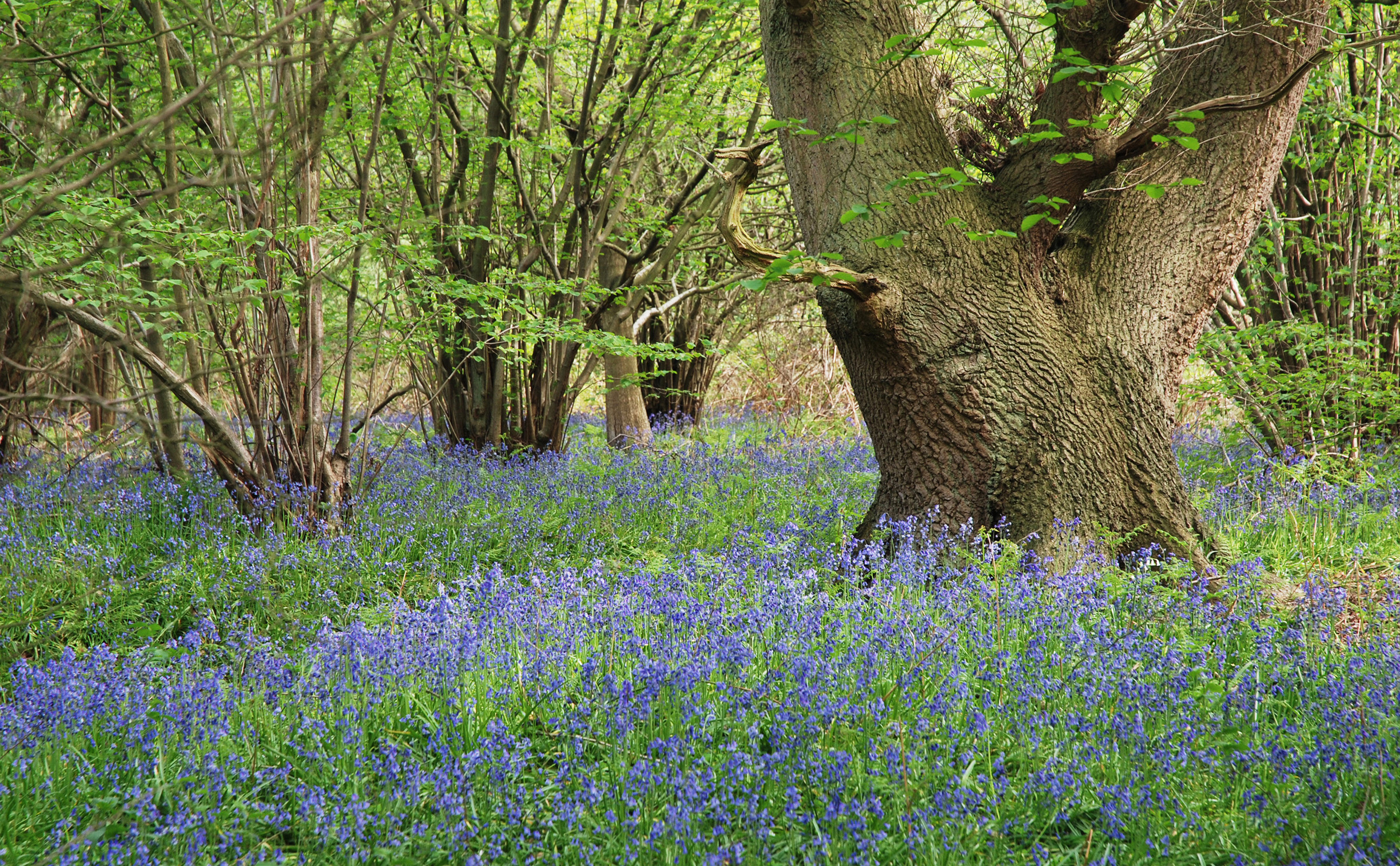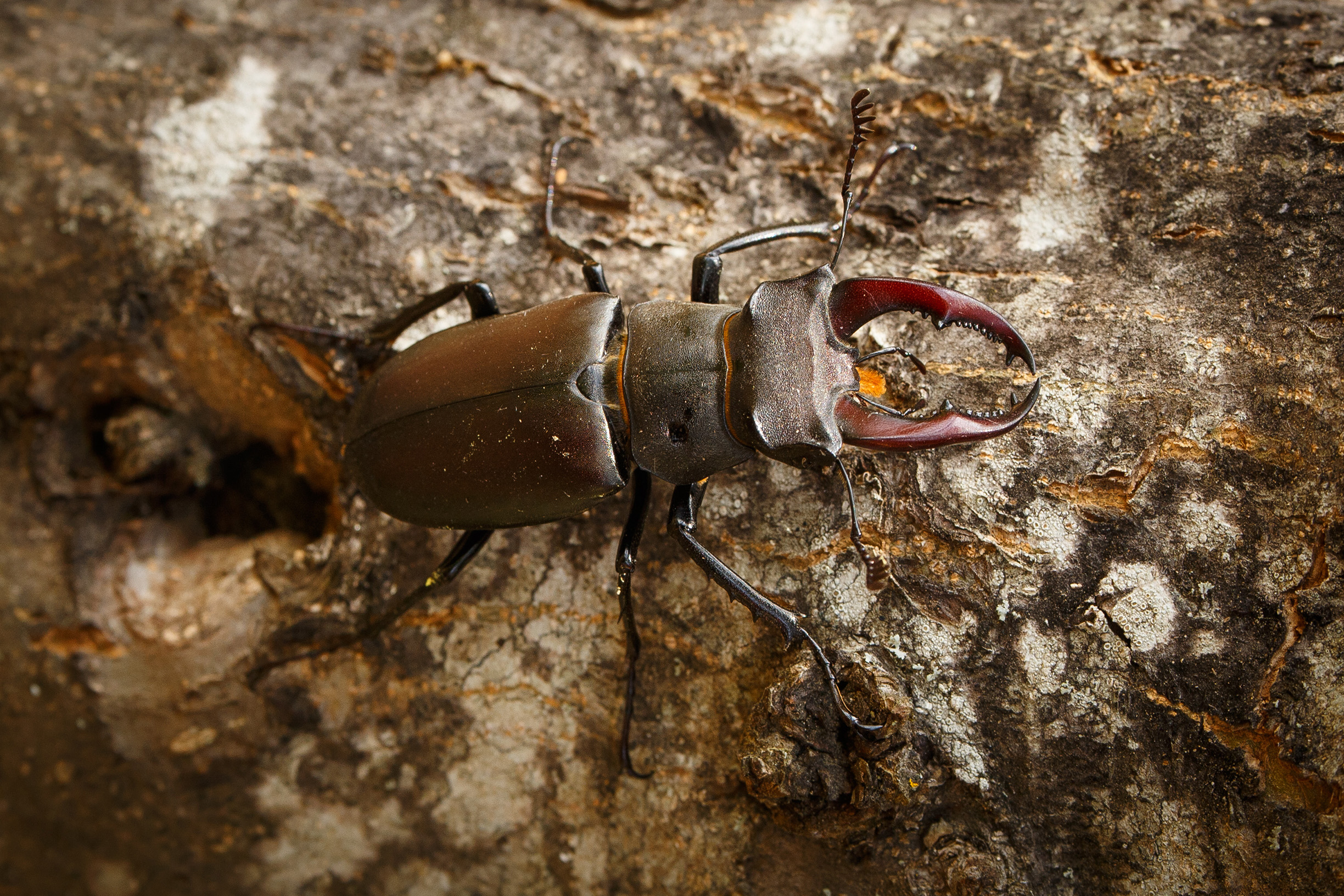This article originally appeared in the fall 2020 edition of Xerces’ magazine, Wings. Click to view the full fall 2020 issue.
To many people, the roar of a chainsaw is a sound of alarm, not conservation. But for England’s surviving ancient woodlands, the chainsaw has become a valuable tool. The noise ripping through the serenity of a winter’s day means the possibility of a springtime walk amidst a carpet of bluebells, conflicting images that encapsulate the story of woodlands that have seen centuries of human use.

In a coppiced woodland, the trees are cut on a regular rotation. Stems regrow from the stump, providing a sustainable harvest of small-diameter wood that supplies a range of commercial uses. Managed for wood products and now conservation, England’s ancient woodlands support a remarkable range of wildflowers and rare insects and the woodlands are an important part of the British countryside. (Photo: Natural England / Peter Roworth [CC BY-NC-ND 2.0].)
As the last glaciation receded from Britain, woodlands spread across most of the landscape. This wildwood was a mixture of trees that included birch, willow, pine, oak, ash, hazel, beech, and lime (known in America as basswood). Dominant trees varied from region to region. For example, in southern England, lime was most common, with a smaller presence of hazel, elm, and oak. The wildwood began to be altered around 4000 BCE as Stone Age settlers opened up the land around their homes, and, as tools improved with the arrival of the Bronze and Iron Ages, so did the rate and extent of clearance. By 500 BCE, half of the country had been cleared.
Our understanding of the early history of the English landscape is based on analysis of pollen deposits in soil, but we gain greater clarity about its evolution once evidence of land ownership began to be written down. Starting in the late seventh century, a body of documentation known as the Anglo-Saxon charters recorded gifts of land—frequently royal grants, such as to help the founding of a monastery. The first comprehensive record, the Domesday Book, was created in the late eleventh century by the French nobleman William of Normandy following his successful invasion. It documents that just 15 percent of the country was wooded.
Subsequent records and the advent of detailed maps make tracking landscape change easier. Over the next several centuries, the income generated by woodland products for domestic use, as well as supplies for small-scale industries that historically manufactured farming tools, barrels, wagon wheels, and many other items, exceeded that from farmland, giving some stability. Even the advent of the Industrial Revolution in the mid-1700s didn’t lead to significant loss. Iron smelting required charcoal, while leather tanning created a market for oak bark, and such demands led to changes in the management and structure of woodlands, but not necessarily their destruction.
Then, in the early 1800s, a boom in agriculture initiated a long, slow decline in the amount of woodland. Much of it that wasn’t lost was dramatically changed by conversion to plantations of exotic species and softwoods. By 1919 England’s woodland cover reached an all-time low of just 5 percent.

A newly cut coppice plot. Such cutting might seem harsh, but the burst of woodland flowers that follows a cut provides habitat for several rare butterflies. In the background is a regrowing plot with standards. The plot has been protected by a fence made of cut poles and branches. (Photo: Natural England / Peter Wakely [CC BY-NC-ND 2.0].)
Because England’s woodlands were the source of many things that were central to everyday life, almost all of them were managed intensively for centuries. (Those that weren’t are inaccessible on steep hills or cliffs.) Woodsmen in all areas traditionally harnessed what Oliver Rackham described in his seminal 1986 work, The History of the Countryside, as the “self-renewing power of trees.” When cut, nearly all trees will regrow from the stump or root, and with care an indefinite number of cropping cycles can be harvested from a woodland. There were two ways in which this was done, coppicing and suckering. In coppicing, a tree is cut to a stump, which remains alive and becomes a “stool” from which shoots regrow. Trees that adapt well to coppicing include ash, hazel, and chestnut. With the second method, suckering, the stump dies after cutting but the roots remain alive and send up new poles. Aspen, cherry, and elm all sucker well.
Woodlands provided many products, with different trees suited to different purposes: hazel supplied hedge stakes, bean rods, and thatching spars; ash was good for tool handles and hay rakes; chestnut was used for fence stakes and gate hurdles; and oak was preferred for wheel spokes, barrels, and construction (and its bark was stripped for the leather-tanning industry). An area might be cut every ten to twenty-five years, the rotation varying with the species of tree and how fast it grows to a usable size. Large trees, frequently oaks, were allowed to grow above everything else, creating a structure known as coppice with standards. When trees of greater size were needed, the standards were felled and converted into timber.
This degree of management meant that woodlands were places of constant disturbance and change. And yet conversely, these were also places that fostered long-term stability. Some of these areas have been woodland since trees colonized the country after glaciation, surviving millennia of clearance and regrowth. Within their boundaries, they are dynamic landscapes, but, within the broader countryside, stable.

You probably can’t imagine the English landscape without woodlands. A source of wood products for centuries, traditional woodland management has resulted in conditions suited to rare wildlife. (Photo: kitmasterbloke [CC BY 2.0].)
After centuries of industrial use, woodlands are now seen as an essential part of the landscape, a valuable wildlife resource, and important for the recreational opportunities they offer, and their future is fought over in the courts of law and of public opinion. This shift in values has resulted in the resumption of coppicing and other traditional management practices to restore the conditions that earlier were continually sustained. Woodlands still provide many traditional products, but conservation and recreation have become core values. Many of the woodlands that are seeing renewed attention are designated “ancient woodland,” a term that has a specific meaning in England: documented to have been woodland since at least 1600 CE. But given the history of the countryside, such areas have probably always been woodland, a direct connection back to the wildwood. Currently, just over 2 percent of England is ancient woodland, though not all of even that small amount is in the semi-natural condition of long-coppiced woods in which the trees occur naturally but their growth is managed.
More than a quarter of “ancient” woodlands are actually classified as “plantations on ancient woodland sites”—meaning that the original trees have been removed and replaced with a plantation, frequently of nonnative species. The best woodlands represent less than 1.5 percent of the country, an area of roughly five hundred thousand acres (two hundred thousand hectares), and even that is fragmented. Many ancient woodlands are small; very few exceed one hundred acres (forty hectares), and many are thirty acres (twelve hectares) or less. With so many pressures on them, it might seem remarkable that any ancient woodlands have survived—but they have, and these places support rich communities of plants and animals.
The regular cycle of cutting and removal of the coppiced or suckered underwood creates patches that are intermittently open and sunny and that burst forth in spring flowers in the years following a cut. Bluebells may be the best known, but there are also vast blooms of primroses, oxlips, and red campion, as well as smaller numbers of dog violets and bugle. Some are closely associated with ancient woodlands and function as indicator species, their presence or absence determining whether or not the woodland is ancient.

The male stag beetle (Lucanus cervus) has fearsome-looking “horns,” but they are harmless. The beetle uses them to flip other males during combat over females. (Photo: Greg_Men [CC BY 2.0].).
Wooded areas also provide refuge for animals, from roe deer (Capreolus capreolus) and badgers (Meles meles) to the lemon slug (Malacolimax tenellus), a rare species that feeds on fungi that are plentiful in ancient woodlands. As with flowers, the presence of lemon slugs can be regarded as an indicator of a woodland’s antiquity.
A host of insects call ancient woodlands home, including the violet click beetle (Limoniscus violaceus), the larvae of which feed on rotting wood, and the stag beetle (Lucanus cervus). One of Britain’s most impressive insects, an adult male stag beetle can be up to three inches (seventy-five millimeters) long. Its larvae are even larger—more than four inches (one hundred millimeters) long—but seldom seen because they live in rotting wood underground. They can take five or more years to develop, so they benefit greatly from the long-term stability of a woodland environment.

Pearl-bordered fritillary (Boloria euphrosyne) nectaring on bugle. This butterfly has disappeared from woodlands that lost their coppice rotation and have become too shaded. (Photo: Gilles San Martin [CC BY-SA 2.0].).
Butterflies are a more obvious component of the insect fauna. A woodland might have thirty-five to forty species, an impressive number considering that fewer than sixty species altogether are resident or regularly recorded in Britain. Many of the species are common and can be found in numerous other places, but some are more specialized. The pearl-bordered fritillary (Boloria euphrosyne) frequents open areas in woodlands, where the adults fly low, nectar on spring flowers, and lay eggs near their preferred caterpillar host plant, dog violet. Considered highly threatened in England, this fritillary has declined rapidly since the 1950s; a major factor in its decline was the cessation of coppicing in many woods. The silver-washed fritillary (Argynnis paphia) also has a close association with woodlands. It too lays its eggs near violets, but usually a few feet up an adjacent tree trunk. Another butterfly of ancient woodlands is the purple emperor (Apatura iris). It is not rare, but is rarely seen because the adults spend most of their time in the treetops, where they feed on sap and aphid honeydew. Its caterpillars munch on goat willow, typically found in wetter areas of woods.
These butterflies have all benefited from the resumption of coppicing in woodlands, but none have gained as much as the heath fritillary (Melitaea athalia), which, without the efforts of conservationists, likely would have been extirpated from Britain. The sunny, warm, sheltered conditions of newly coppiced woodlands provide ideal conditions. Its common name may not reflect the essential relationship between butterfly and coppice, but its habit of appearing in freshly cut plots gave rise to the alternative name “woodman’s follower.”

Colonies of the heath fritillary (Melitaea athalia) can increase to thousands of individuals within a few years in a sunny clearing created by coppicing. When the trees regrow, the butterflies move on to other freshly cut areas. (Photo: Juri Kowski [CC BY-SA 2.0].).
Having grown up in Britain, my own connections with ancient woodlands come from childhood wildflower walks; volunteering as a student, during which I was first introduced to coppicing; and several years working in southern England, where I had the good fortune to help manage such areas in Bedfordshire, Oxfordshire, and Essex, three counties with magnificent ancient woodlands. Those jobs allowed me to immerse myself in the sounds, smells, and feel of these special places. I worked with landowners and land managers to reintroduce coppicing, with local councils to influence policy to preserve woodlands, and with government agency staff to find ways to support good management, and thus had the opportunity to witness efforts to achieve long-term change. I’ve also, I admit, put myself physically in the path of bulldozers to protect valuable sites.
England’s woodland cover has rebounded from its low point in the early decades of the twentieth century, and has now reached 10 percent. (The figures are slightly different across the United Kingdom, with 15 percent cover in Wales, 19 percent in Scotland, and 9 percent in Northern Ireland.) There has been considerable government funding for woodland planting on private land through farm-support programs as well as a dozen Community Forests established in the 1990s. Recently, the British government declared a goal of thirty thousand hectares (seventy-four thousand acres) of new woodlands in England to mitigate climate change. While this is a good plan, considerable care must be taken not to plant trees on habitats such as meadows, heathlands, and chalk downlands, areas that support their own unique wildlife that would be destroyed by conversion to woodland.
In time, new plantings will provide homes for woodland plants and animals, but the ancient woodlands remain of utmost importance and the need for vigilance is ongoing. There is constant threat from development, with woodlands lost bit by bit to housing, roads, and other construction. We need to conserve and carefully manage the surviving ancient woodlands, for which the chainsaw is the modern version of the ax and the crosscut saw, allowing a continuation of the traditions that stretch back for centuries.
Further Reading
Read the entire fall 2020 issue of Wings. The theme is forests and woodlands. (Download as PDF.)




